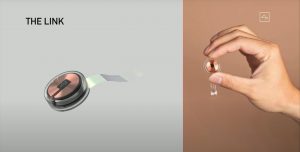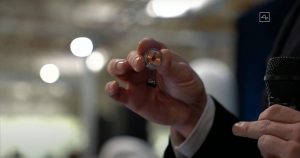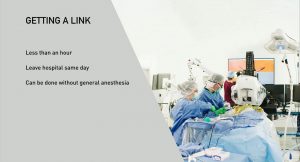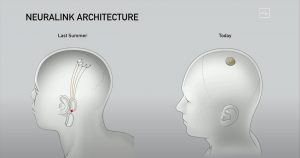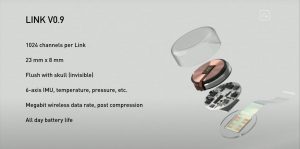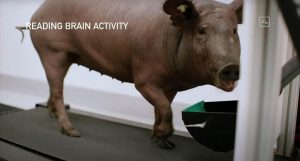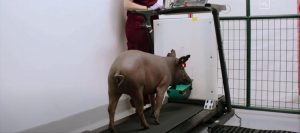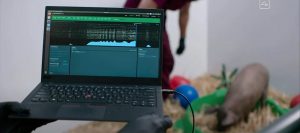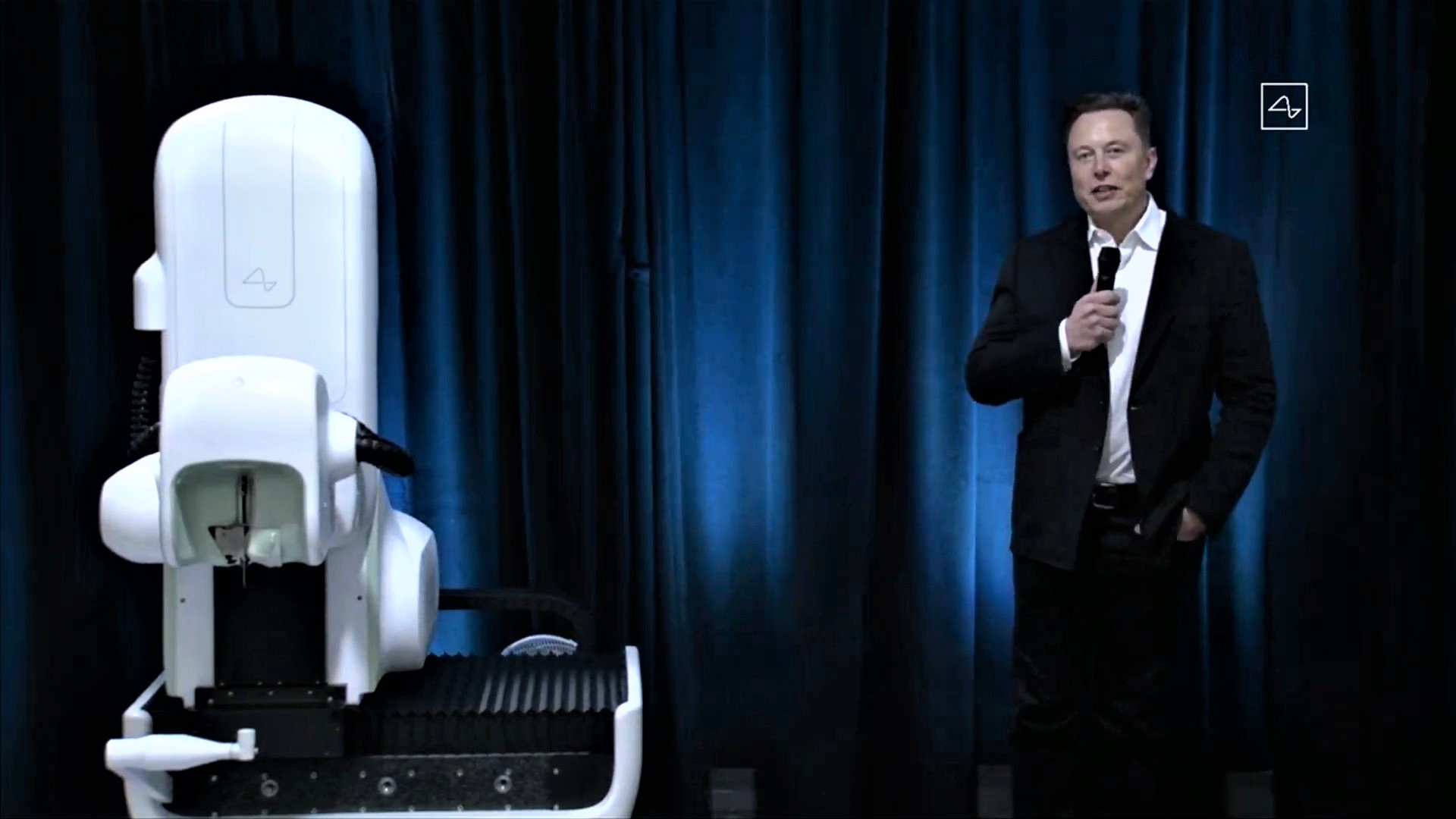
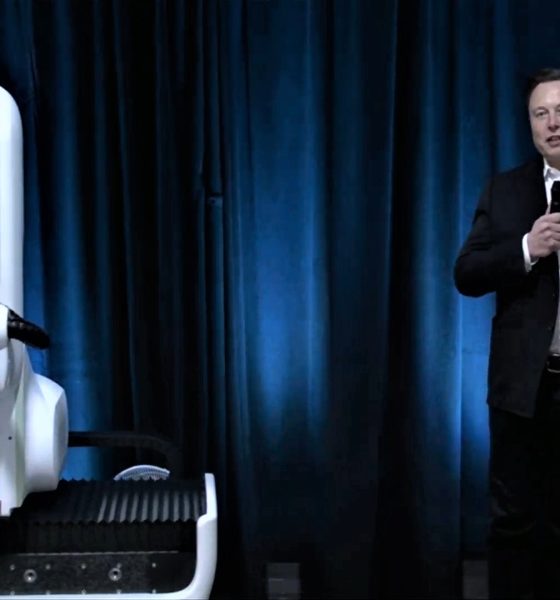
News
Elon Musk’s Neuralink unveils sleek V0.9 device, uses sassy pigs for live brain machine demo
After another year of successfully staying in the shadows, Elon Musk’s Neuralink has revealed what’s been going on behind the scenes in terms of technological progress. In a live streamed event on Friday afternoon, the brain-machine interface company gave a demonstration, took questions, and left audiences with even more to mull over than ever.
“The primary purpose of this demo is recruiting,” Musk stated at the very beginning of the presentation. He emphasized that everyone at some point in their life will face a brain or spine problem – all inherently electrical – meaning it takes electrical solutions to solve electrical problems. Neuralink’s goals are to solve these problems for anyone who wants them solved, and that application will be simple and reversible with no negative effects.
Two pigs were used for the ‘real-time’ demonstration promised in the days leading up to the event. The first, named Gertrude, had a Neuralink implant installed for two months and was shown to be healthy and happy. A second pig, named Dorothy, had the implant previously installed and removed with no side effects afterward.
- Elon Musk shows off the Neuralink v0.9 Device (Credit: Neuralink)
After a bit of a delay from the amusingly sassy Neuralink-implanted pigs, the live stream and in-house audience witnessed Gertrude’s device in action. Notably, the neural implants could predict all the limb movements of the pigs based on the neural activity being read. Each reading was shown on a screen and musical notes attached as the data was processed.
Overall, here are some of the main takeaways from the presentation.
- The Neuralink implant device has been dramatically simplified since Summer 2019. Its design will be very low profile and nearly invisible on the outside, leaving only a small scar that could be covered by hair. “It’s like a FitBit in your skull with tiny wires,” Musk half-joked. “I could have it right now and you wouldn’t even know. Maybe I do!”
- The implant device is inductively charged, much like wireless smartphones are charged. It will also have functions that are akin to those available on smartwatches today.
- A “smart” robot installs the device, which requires engineering talent to accomplish, hence the recruiting focus of the Neuralink event. The “V2” robot featured in this year’s presentation looks like a step up from last year’s machine.
- The electrodes are installed without general anesthesia, no bleeding, and no noticeable damage. The currently developed robot has done all the current implant installations to date.
- The implant can be installed and removed without any side effects.
- You can have multiple Neuralink devices implanted and they will work seamlessly.
- The implant device would have an application linked to your phones.
- Neuralink received a ‘breakthrough device’ designation from the FDA in July, and the company is working with the agency to make the technology as safe as possible.
- The device will eventually be able to be sewn deeper within the brain, thereby having access to a greater range of functions beyond the upper cortex. Examples are motor function, depression, and addiction.
- Getting a Neuralink should take less than an hour, without the need for general anesthesia. Users could have the surgery done in the morning and go home later during the day.
- Credit: Neuralink
- Credit: Neuralink
The idea for Musk’s AI-focused brain venture first seemed to really take off after his appearance at Vox Media’s Recode Code Conference in 2016. The CEO had discussed the concept of a neural lace device on several occasions up to that point and suggested at the conference that he might be willing to tackle the challenge himself. A few months later, he revealed that he was in fact working on the idea, which was detailed at great length by Tim Urban on his website Wait But Why.
“He started Neuralink to accelerate our pace into the Wizard Era—into a world where he says that ‘everyone who wants to have this AI extension of themselves could have one, so there would be billions of individual human-AI symbiotes who, collectively, make decisions about the future.’ A world where AI really could be of the people, by the people, for the people,” Urban summarized. Given that bigger picture perspective, the 2020 Neuralink event seems even more impactful.
Neuralink’s official Twitter account opened the virtual floor to questions using the #askneuralink hashtag the night before the event, prompting several questions during the presentation. However, Musk fanned the building curiosity in the hours beforehand. “Giant gap between experimental medical device for use only in patients with extreme medical problems & widespread consumer use. This is way harder than making a small number of prototypes,” Musk responded to one question directed towards the mass market viability of a future Neuralink product line.
https://twitter.com/flcnhvy/status/1299422178329362437
Also in the days prior to the Neuralink event, Musk teased a few more bits of information about what to expect. “Live webcast of working @Neuralink device,” he said. Just prior to his confirmation of the device demonstration, he revealed that version two of the robot initially shown in the first progress update in 2019 wasn’t quite up to the level of a LASIK eye surgery machine, though only a few years away.
You can watch the full event below:

News
Tesla (TSLA) receives “Buy” rating and $551 PT from Canaccord Genuity
He also maintained a “Buy” rating for TSLA stock over the company’s improving long-term outlook, which is driven by autonomy and robotics.

Canaccord Genuity analyst George Gianarikas raised his Tesla (NASDAQ:TSLA) price target from $482 to $551. He also maintained a “Buy” rating for TSLA stock over the company’s improving long-term outlook, which is driven by autonomy and robotics.
The analyst’s updated note
Gianarikas lowered his 4Q25 delivery estimates but pointed to several positive factors in the Tesla story. He noted that EV adoption in emerging markets is gaining pace, and progress in FSD and the Robotaxi rollout in 2026 represent major upside drivers. Further progress in the Optimus program next year could also add more momentum for the electric vehicle maker.
“Overall, yes, 4Q25 delivery expectations are being revised lower. However, the reset in the US EV market is laying the groundwork for a more durable and attractive long-term demand environment.
“At the same time, EV penetration in emerging markets is accelerating, reinforcing Tesla’s potential multi‑year growth runway beyond the US. Global progress in FSD and the anticipated rollout of a larger robotaxi fleet in 2026 are increasingly important components of the Tesla equity story and could provide sentiment tailwinds,” the analyst wrote.
Tesla’s busy 2026
The upcoming year would be a busy one for Tesla, considering the company’s plans and targets. The autonomous two-seat Cybercab has been confirmed to start production sometime in Q2 2026, as per Elon Musk during the 2025 Annual Shareholder Meeting.
Apart from this, Tesla is also expected to unveil the next-generation Roadster on April 1, 2026. Tesla is also expected to start high-volume production of the Tesla Semi in Nevada next year.
Apart from vehicle launches, Tesla has expressed its intentions to significantly ramp the rollout of FSD to several regions worldwide, such as Europe. Plans are also underway to launch more Robotaxi networks in several more key areas across the United States.
News
Waymo sues Santa Monica over order to halt overnight charging sessions
In its complaint, Waymo argued that its self-driving cars’ operations do not constitute a public nuisance, and compliance with the city’s order would cause the company irreparable harm.

Waymo has filed a lawsuit against the City of Santa Monica in Los Angeles County Superior Court, seeking to block an order that requires the company to cease overnight charging at two facilities.
In its complaint, Waymo argued that its self-driving cars’ operations do not constitute a public nuisance, and compliance with the city’s order would cause the company irreparable harm.
Nuisance claims
As noted in a report from the Los Angeles Times, Waymo’s two charging sites at Euclid Street and Broadway have operated for about a year, supporting the company’s growing fleet with round-the-clock activity. Unfortunately, this has also resulted in residents in the area reportedly being unable to sleep due to incessant beeping from self-driving taxis that are moving in and out of the charging stations around the clock.
Frustrated residents have protested against the Waymos by blocking the vehicles’ paths, placing cones, and “stacking” cars to create backups. This has also resulted in multiple calls to the police.
Last month, the city issued an order to Waymo and its charging partner, Voltera, to cease overnight operations at the charging locations, stating that the self-driving vehicles’ activities at night were a public nuisance. A December 15 meeting yielded no agreement on mitigations like software rerouting. Waymo proposed changes, but the city reportedly insisted that nothing would satisfy the irate residents.
“We are disappointed that the City has chosen an adversarial path over a collaborative one. The City’s position has been to insist that no actions taken or proposed by Waymo would satisfy the complaining neighbors and therefore must be deemed insufficient,” a Waymo spokesperson stated.
Waymo pushes back
In its legal complaint, Waymo stated that its “activities at the Broadway Facilities do not constitute a public nuisance.” The company also noted that it “faces imminent and irreparable harm to its operations, employees, and customers” from the city’s order. The suit also stated that the city was fully aware that the Voltera charging sites would be operating around the clock to support Waymo’s self-driving taxis.
The company highlighted over one million trips in Santa Monica since launch, with more than 50,000 rides starting or ending there in November alone. Waymo also criticized the city for adopting a contentious strategy against businesses.
“The City of Santa Monica’s recent actions are inconsistent with its stated goal of attracting investment. At a time when the City faces a serious fiscal crisis, officials are choosing to obstruct properly permitted investment rather than fostering a ‘ready for business’ environment,” Waymo stated.
News
Tesla FSD v14.2.2 is getting rave reviews from drivers
So far, early testers have reported buttery-smooth drives with confident performance, even at night or on twisty roads.

Tesla Full Self-Driving (Supervised) v14.2.2 is receiving positive reviews from owners, with several drivers praising the build’s lack of hesitation during lane changes and its smoother decision-making, among others.
The update, which started rolling out on Monday, also adds features like dynamic arrival pin adjustment. So far, early testers have reported buttery-smooth drives with confident performance, even at night or on twisty roads.
Owners highlight major improvements
Longtime Tesla owner and FSD user @BLKMDL3 shared a detailed 10-hour impression of FSD v14.2.2, noting that the system exhibited “zero lane change hesitation” and “extremely refined” lane choices. He praised Mad Max mode’s performance, stellar parking in locations including ticket dispensers, and impressive canyon runs even in dark conditions.
Fellow FSD user Dan Burkland reported an hour of FSD v14.2.2’s nighttime driving with “zero hesitations” and “buttery smooth” confidence reminiscent of Robotaxi rides in areas such as Austin, Texas. Veteran FSD user Whole Mars Catalog also demonstrated voice navigation via Grok, while Tesla owner Devin Olsen completed a nearly two-hour drive with FSD v14.2.2 in heavy traffic and rain with strong performance.
Closer to unsupervised
FSD has been receiving rave reviews, even from Tesla’s competitors. Xpeng CEO He Xiaopeng, for one, offered fresh praise for FSD v14.2 after visiting Silicon Valley. Following extended test drives of Tesla vehicles running the latest FSD software, He stated that the system has made major strides, reinforcing his view that Tesla’s approach to autonomy is indeed the proper path towards autonomy.
According to He, Tesla’s FSD has evolved from a smooth Level 2 advanced driver assistance system into what he described as a “near-Level 4” experience in terms of capabilities. While acknowledging that areas of improvement are still present, the Xpeng CEO stated that FSD’s current iteration significantly surpasses last year’s capabilities. He also reiterated his belief that Tesla’s strategy of using the same autonomous software and hardware architecture across private vehicles and robotaxis is the right long-term approach, as it would allow users to bypass intermediate autonomy stages and move closer to Level 4 functionality.
